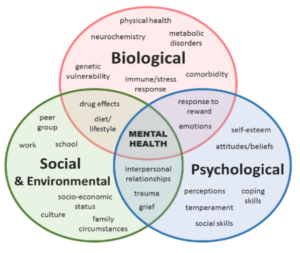Wellness
The definition of wellness varies depending on context and is often linked to the concept of health, but there are important differences. Health has been conceptualized as a state of being (one’s physical, psychological, social well-being), while wellness is an active practice to make healthy choices and develop positive habits towards a healthier and more fulfilling life. In short: health is a state of being, while wellness is an active state of living, thriving.
Biopsychosocial Model
The biopsychosocial model conceptualized by George Engle reflects the concept that understanding one’s health cannot be viewed through biological factors alone, that it is important to also consider social and emotional factors that also play a role in an individual’s overall functioning. There is a complex interaction between biological factors (genetic, biochemical, nutrition), psychological factors (mood, personality, trauma, temperament, coping style), and social factors (cultural, familial, socioeconomic).

Wellness By Design SEL programing takes into consideration the biological factors that may impact learning (ex: atypical brain development, substance exposure, stress, anxiety, etc) and utilizes one of the most effective multi-sensory delivery systems to children and adults – through arts based learning.

